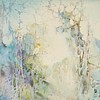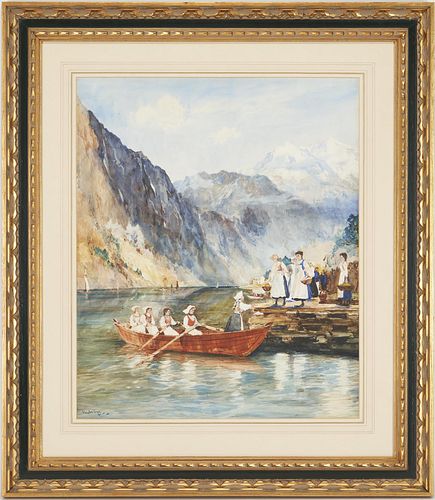Lot 158
Charles Dixon W/C Painting, Women in Rowboat along Riverbank
Estimate: $900 - $1,000
Unsold
Bid Increments
| Price | Bid Increment |
|---|---|
| $0 | $10 |
| $100 | $25 |
| $500 | $50 |
| $1,000 | $100 |
| $3,000 | $200 |
| $5,000 | $500 |
| $10,000 | $1,000 |
| $20,000 | $2,000 |
| $50,000 | $5,000 |
| $100,000 | $10,000 |
Charles Edward Dixon (England, 1872-1934) watercolor on paper painting depicting a group of traditionally dressed women in a rowboat upon a large body of water, possibly the Rhine River, alongside a small dock conversing with another group of women carrying baskets standing along the edge. Additional row and sailboats dot the river in the midground with a white, two-story building and steep mountains with rocky and snowy peaks, possibly the Alps, fill the background beneath a cloud-filled sky. Signed and dated "Charles Dixon 1910" lower left. Antiquarian Gallery sticker label, en verso of frame. Housed and matted under glass in a carved giltwood frame with a black-painted fillet. Sight: 27 1/4" H x 22 1/2" W. Framed: 39 3/8" H x 34 3/8" W. Biography: "Dixon was an English painter, born in Goring-on-Thames in Oxfordshire on 8 December 1872. His father Alfred (active 1864-1891) was a painter of domestic genre scenes. Very little is known about Charles's early life although it is presumed that he learnt his craft from his father. He soon became a popular and successful painter of marine scenes, working in both oils and watercolours. His watercolour works, of which there are five in the National Maritime Museum, London, tend to be views of sea and coastal scenes. His larger oil paintings record contemporary events at sea, such as his 'Queen Victoria's Diamond Jubilee at Spithead, 1897' and, after the First World War, 'HMS Cardiff Leading the Surrendered German High Seas Fleet into Rosyth' (both in the National Maritime Museum, London). He exhibited regularly at the Royal Academy and the New Watercolour Society. He also contributed illustrations to The Graphic magazine and other periodicals. He was made a member of the Royal Institute of Painters in Watercolours in 1900. He lived at Itchenor on the Sussex coast and died on 12 September 1934." (adapted from the National Maritime Museum, Greenwich, London).
The Estate of Carl Klein, Brentwood, Tennessee.
Overall very good condition with minute surface grime or errant mark to upper right quadrant near the edge and slight surface abrasion, measuring 1 1/4" L, to the upper right sky. Not examined outside of frame. Frame with minor scattered surface wear.
The Estate of Carl Klein, Brentwood, Tennessee.
Condition
The UPS Store of Bearden 865-584-0081 (press 5), fax 865-584-0094 store2630@theupsstore.com Click to get a quote
The UPS Store of Northshore Knoxville Contact – Eve 865-951-2499 store6461@theupsstore.com
John & Max Express LLC NOTE: large items & white glove delivery services only (driving range limitations may apply) Contact – Dina 865-230-1568 johnmaxexpress@gmail.com








